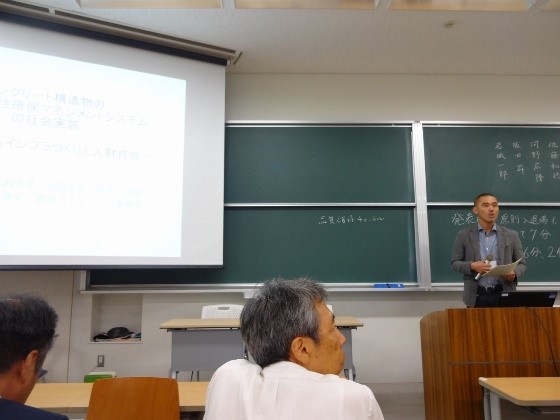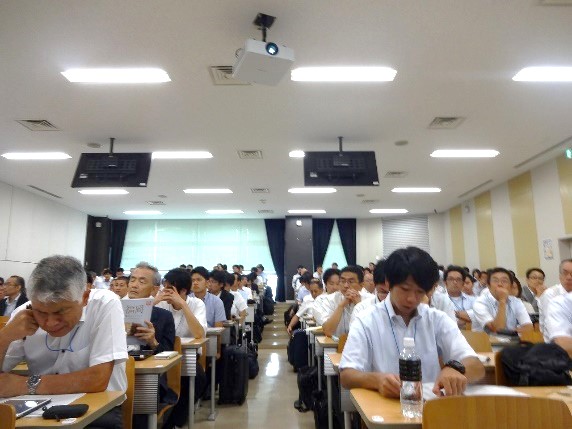A panel discussion was held jointly by the concrete committee and the management committee as a part of the Japan Society of Civil Engineers 2017 annual meeting at the Ito campus of Kyushu University on September 11, 2017. The chair was Dr. Akira Hosoda (Yokohama National University). Six speakers gave 10-minute presentations related to the system that ensures concrete quality and durability: Dr. Hosoda, Mr. Jun Ninomiya (West Nippon Expressway Engineering Chugoku Co. Ltd.), Prof. Kazunori Sato (Nihon University), Prof. Hirotaka Kawano (Kyoto University), Dr. Noboru Sakata (Kajima Corporation), and Ichiro Iwaki (Nihon University). A system for inhibiting concrete cracking, the proposed by Yamaguchi prefectural government, has been developed into a system that ensures concrete quality. The subcommittee on “Study of Management to Ensure the Quality and Durability of Concrete Structures E(JSCE-229) based on the system was set up last year as a priority issue and reported the results of the study this July.
|
Presentation by six speakers
Presentation by Mr. Ninomiya
In Yamaguchi prefecture, both the owner and the constructor used a check sheet for concrete quality to avoid arguments over cracks. For the past 10 years, the Yamaguchi prefectural government has been compiling a database of information about how to inhibit concrete cracking. Major construction companies have extensive experience, but small companies in Yamaguchi prefecture lack data and may not be able to resolve issues by themselves. Therefore, Yamaguchi prefectural government created the database system using the major companies Eknowledge. The six checksheets are made for one concrete lift based on the JSCE concrete specification (construction). For example, the locations of vibrations are noted on the checksheet. After installing the system, cracking due to inadequate construction has decreased. The information is accessible from the Yamaguchi prefecture homepage and is available to everyone. Owing to the success of this system, many engineers from other prefectural governments, universities, and companies have come to Yamaguchi prefecture.
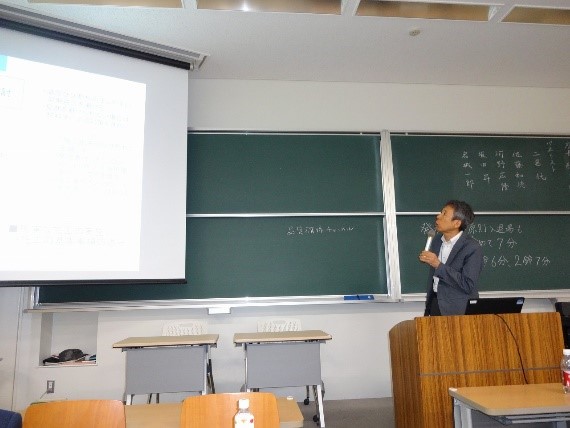
Mr. Ninomiya
Deterioration due to deicing agents containing chloride was found before the 2011 Tohoku earthquake and the structure needed to be repaired only for 30-40 years in the worse cases. Since no clear regulations exist for the deicing agent, road owners have extensively used the agents to avoid traffic accidents. After the earthquake, roads needed to be reconstructed, but these roads are expected to deteriorate if they are constructed using conventional methods and designs. I wanted to change the construction requirements to avoid deterioration, but there were many objections because no precedent existed and the cost of improving durability was higher. To convince colleagues, I informed them of the reality of deterioration and then explained the need to ensure the quality and durability of concrete. Once government, industry, and academia share a goal, they can collaborate to improve durability. Deterioration is analyzed and a countermeasure tested in the laboratory. If the results show that the countermeasure is effective, it is quickly applied to actual structures. The air content to even not follow JIS was applied according to the environmental conditions and an antirust coating was applied to PC beams. In the case of slabs, fly ash or slag cement is used to avoid ASR. The Tohoku regional bureau of the Ministry of Land, Infrastructure, Transport and Tourism also has adopted the Yamaguchi prefectural government’s PDCA cycle system to ensure quality and durability. If the previous concrete lift had problems, the measures should be reflected in the next lift. Consequently, the last lift, constructed by the same company, had no problem. If an insufficient countermeasure is applied to avoid the increased cost, the repair cost may increase. If the spirit to construct good structures is shared, good structures can be built.
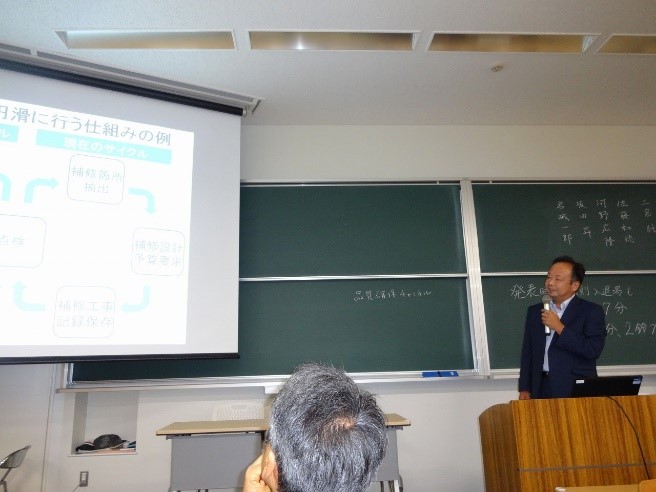
Prof. Sato
In 2001, the Ministry of Land, Infrastructure, Transport and Tourism requested that the quality of concrete structure be ensured in order to improve durability. Engineers, however, focused excessively on cracking. It is difficult to determine through inspections whether or not cracks are detrimental, but cracks continue to be inspected ambiguously. In one case, an owner ordered the constructors to construct good quality structures but did not try to work with the constructors to follow the manual and regulations. Consequently, cracking problems often arose. In my opinion, good management makes everyone happy. Each person has a role to play in constructing good structures. Cracking issues can only be resolved by working together. In the case of Yamaguchi prefecture, the owner finally realized this point. By using the check sheet, the owner and constructor shared and discussed the information. It was considered a success when they realize that, in some cases, cracking is possible even after applying countermeasures. It is also important to learn about good structures by visiting. It is criminal to not apply countermeasures when it is known that the service life of the structure will be shorter without the countermeasures.
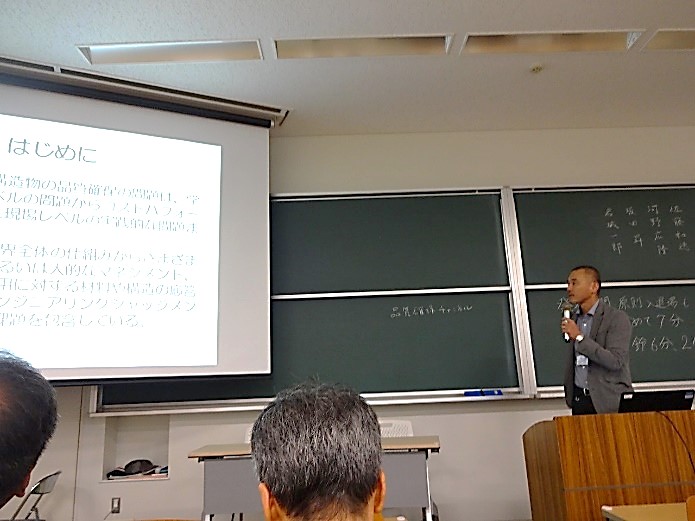
Dr. Hosoda
In Europe, engineers are appreciated because they provide enhanced judgement based on the situation and take responsibility for their judgment. In Japan, judgements are often based on the manual, and while prior assessments are done, post assessments (review) are not. The PDCA cycle is important at the governmental level. To improve durability, cracking is inhibited. It is not right for the inhibition of cracking to be the objective. In one strange example, a joint is constructed to intentionally induce cracking even in a beam. It is important to determine the objective by inspecting actual structures based on the PDCA cycle. This will successfully merge engineering and management.
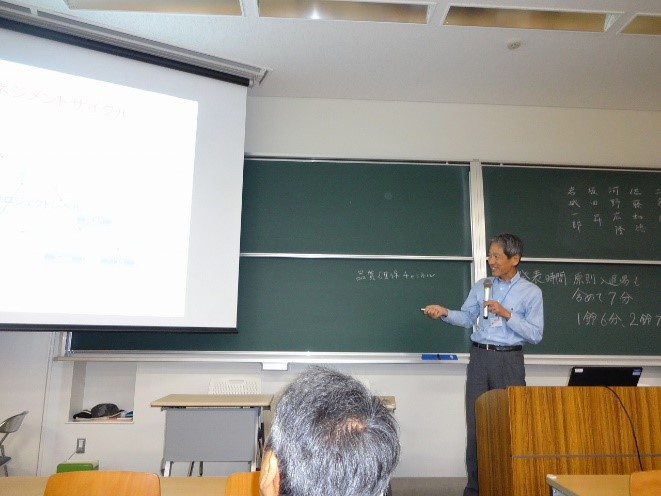
Prof. Kawano
In order to assure the quality and durability of concrete structures, design, construction, and materials should be linked. In reality, however, design and construction are not linked well. When the focus is on construction, for example, quality can be improved by removing the haunch of a box culvert and the taper of a slab for an inversed T-type retaining wall. Ways to improve productivity and quality are summarized in the JSCE concrete library written by subcommittee (JSCE-267). The library aims to provide owners with a guideline that reflects the JSCE concrete specification and will lead to research.
To construct good structures, engineers must undergo training. In the case of Kajima cooperation, all civil engineers must be certified by the Japan Concrete Institute as concrete engineers. Kajima Corporation’s construction manual is shared among engineers and workers. Engineers and workers must also visually inspect several important items. Communications between engineers and workers will gradually improve construction.
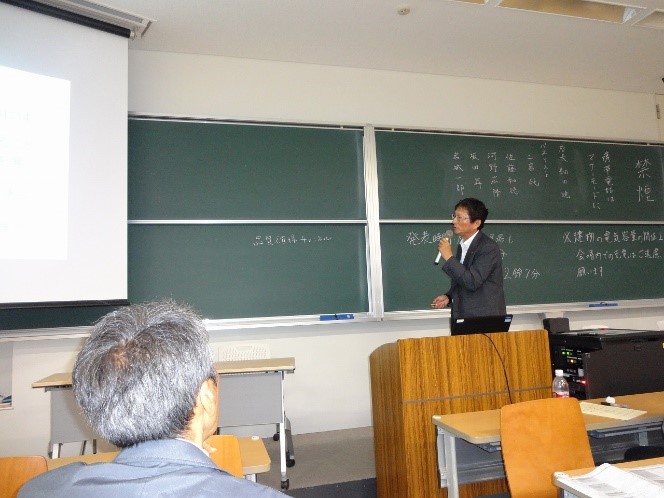
Dr. Sakata
I have been involved in a project to assess slabs, which is one of topics in the Infrastructure Maintenance, Renovation, and Management of Cross-ministerial Strategic Innovation Promotion Program (SIP). This project has examined how to extend the life of new or replaced slabs and how to maintain and preserve existing slabs. Precast slabs have a high fatigue life, but their long-term durability also should be studied. In addition, although the precast slab itself has high structural performance, the joint can be weak. Since it is important to propose a structural design with as few weak portions as possible, a new joint design is being investigated. A standard-size slab was constructed at the university to study deterioration. For example, when ASR (Alkali Silica Reaction) was promoted in the slab, it was found that the swelling characteristic is dependent on the ambient temperature. A large amount of swelling is observed in the summer, while in the winter, the amount of swelling is small. ASR swelling also has strong anisotropy. The cracking patterns on the top and bottom surfaces are greatly affected by the boundary restrained conditions in the actual structure. Salt attacks are also investigated in various regions where this is an environmental concern. The findings should be reflected in the maintenance.
The above study concerns enhanced maintenance, but it is also important to maintain the small structures on local residential roads. Since the structures are numerous and the budgets limited, enhanced maintenance is difficult, but simple preventive measures supported by local residents are useful. In Fukushima, civil engineers are trained for five years and local residents support the daily maintenance based on a simplified inspection sheet created by university students. The sheet has been distributed at local events, such as cultural festivals. A smartphone checking system also has been developed for the younger generation. It is important to impart an interest and a love for structures to local governments, universities, companies, and residents.

Prof. Iwaki
Question and Discussion
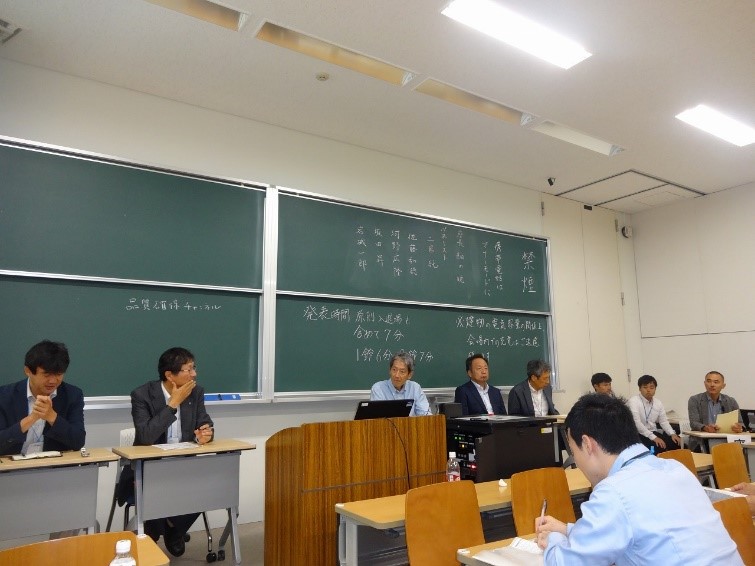
Panel discussion
Designs and materials are often optimized in civil engineering, but construction has not received much focus. It is important to understand that a design that considers the ease of construction will lead to improved quality and durability of concrete structures.
The big issue of deicing agents is combined degradation. The agent may cause salt attack, ASR, and freezing damage. Fatigue is also involved in the deterioration of slabs. It is very difficult to protect a structure against combined attacks for 100 years. Hence, it is important to avoid as much as possible each instance deterioration based on the current countermeasure for the attack.
Big efforts and a proposal to construct good structures with improved quality and durability finally lead to money. In the case of reconstruction after the earthquake, the cycle was fast, but in the other regions, it should be step by step.
For the training, it is important to say that the current situation is not good, rather than say that the current situation is ok, and to share this information. If engineers do not think that cracking is possible, but think that stronger countermeasures to avoid cracking are necessary, then cracking is avoidable. The government is likely to follow precedents, but it should change the education system to improve produce highly motivated engineers. Proper education is important.
Regarding sustainability, awareness of the need to maintain infrastructure is important. The key is how ownership is shared with citizens. We recognize that it is not easy.
Revisions are important for the system. The Yamaguchi prefectural government revises the system every year. Revisions to improve the system are necessary for sustainability.
